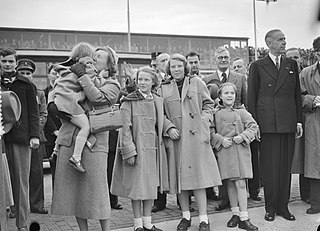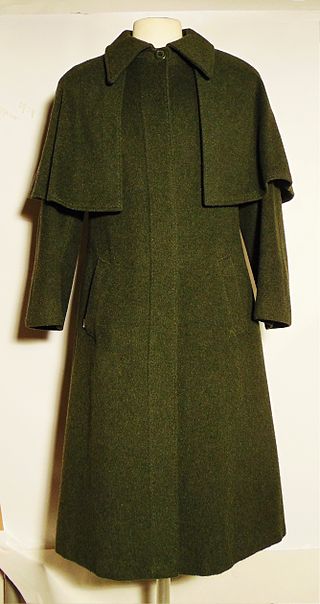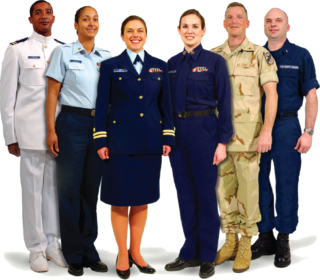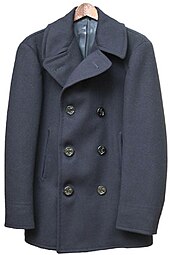
A trench coat is a variety of coat made of waterproof heavy-duty fabric, originally developed for British Army officers before the First World War, and becoming popular while used in the trenches, hence the name trench coat.

A jacket is a garment for the upper body, usually extending below the hips. A jacket typically has sleeves and fastens in the front or slightly on the side. A jacket is generally lighter, tighter-fitting, and less insulating than a coat, which is outerwear. Some jackets are fashionable, while others serve as protective clothing. Jackets without sleeves are vests.

Gabardine is a durable twill worsted wool, a tightly woven fabric originally waterproof and used to make suits, overcoats, trousers, uniforms, windbreakers, outerwear and other garments.

A blazer is a type of jacket resembling a suit jacket, but cut more casually. A blazer is generally distinguished from a sport coat as a more formal garment and tailored from solid colour fabrics. Blazers often have naval-style metal buttons to reflect their origin as jackets worn by boating club members.

A duffel coat is a coat made from duffel cloth, designed with toggle-and-rope fastenings, patched pockets and a large hood. The name derives from Duffel, a town in the province of Antwerp in Belgium where the manufacturing process of this kind of fabric, a coarse, thick, woolen cloth originated. Duffel bags were originally made from the same material.

The U.S. Army's M1943 uniform was a combat uniform manufactured in windproof cotton sateen cloth introduced in 1943 to replace a variety of other specialist uniforms and some inadequate garments, like the M1941 Field Jacket. It was used through the remainder of World War II and into the Korean War with modifications before being replaced by the OG-107 uniform beginning in 1952.
The United States Army in World War II used a variety of standard and non-standard dress and battle uniforms, which often changed depending upon the theater of war, climatic environment, and supply exigencies.

The uniforms of the United States Navy include dress uniforms, daily service uniforms, working uniforms, and uniforms for special situations, which have varied throughout the history of the navy. For simplicity in this article, officers refers to both commissioned officers and warrant officers.

The Eisenhower jacket or "Ike" jacket, officially known as the Jacket, Field, Wool, Olive Drab, is a type of waist-length jacket developed for the U.S. Army during the later stages of World War II and named after Dwight D. Eisenhower. Intended to be worn on its own or as an insulating layer beneath the M-1943 Field Jacket and over the standard wool flannel shirt and wool sweater, it featured a pleated back, adjustable waist band, fly-front buttons, bellows chest pockets, slash side pockets, and shoulder straps.
Kersey is a kind of coarse woollen cloth that was an important component of the textile trade in Medieval England.
The manufacture of textiles is one of the oldest of human technologies. To make textiles, the first requirement is a source of fiber from which a yarn can be made, primarily by spinning. The yarn is processed by knitting or weaving, which turns yarn into cloth. The machine used for weaving is the loom. For decoration, the process of colouring yarn or the finished material is dyeing. For more information of the various steps, see textile manufacturing.

A mariner's cap also called a skipper's cap,sailor's cap,Dutch Boy's cap, or fiddler's cap, is a peaked cap, usually made from black or navy blue wool felt, but also from corduroy or blue denim. Originally popular with seafarers, it is often associated with sailing and maritime settings, especially fishing, yachting and recreational sailing. It has sometimes become a fashion item in the West, for example being worn by John Lennon in the mid-1960s.

Workwear is clothing worn for work, especially work that involves manual labour. Often those employed within trade industries elect to be outfitted in workwear because it is built to provide durability and safety.
The Richmond Depot, or the Richmond Clothing Bureau, was a clothing and equipment facility located in three primary facilities, in and around Richmond, Virginia, established late in 1861, that supplied uniforms, footwear, and other equipment to the Confederate States Army, primarily the Army of Northern Virginia, and the surrounding region of the Commonwealth of Virginia. Richmond Depot uniforms were not issued to western or Deep South Confederates, such as the Army of Tennessee.
The military uniforms of the Union Army in the American Civil War were widely varied and, due to limitations on supply of wool and other materials, based on availability and cost of materials. The ideal uniform was prescribed as a dark blue coat with lighter pants, with a black hat. Officer's ranks were denoted with increasing levels of golden decoration. Specific jobs, companies, and units had markedly different styles at times, often following European customs such as that of the Zouaves. Officers uniforms tended to be highly customized and would stray from Army standard. Ironically, several main pieces of gear had been created by order of the U.S. War Secretary Jefferson Davis before the war; he later became Confederate President.
Each branch of the Confederate States armed forces had its own service dress and fatigue uniforms and regulations regarding them during the American Civil War, which lasted from April 12, 1861, until May 1865.

Wool barathea evening waistcoat with silk collar and lining]]

A loden cape is an overcoat of Tyrolean origin, made of a thick, water-resistant woolen material with a short pile known as loden cloth, first produced by peasants in Austria. This fabric is derived from the coarse, oily wool of mountain sheep and has a traditional earthy green colour. The name is derived from Middle High German "lode" or from Old High German "lodo", meaning "coarse cloth". It is a cloth of traditional Tracht worn in Tyrol.
Melton cloth is traditionally made of wool and is woven in a twill form. It is thick, due to having been well fulled, which gives it a felt-like smooth surface. It is napped and very closely sheared. Meltons are similar to Mackinaw cloth. It is a very solid cloth in which the twill weave pattern is completely concealed due to the finishing processes. Because of its dense, quasi-felted texture it frays minimally or not at all. It is hard wearing and wind and weather resistant. Its main use is for heavy outer garments and coats and for blankets. In lighter weights melton cloth is traditionally used for lining the underside of jacket collars.

The Uniforms of the United States Coast Guard include dress uniforms, daily service uniforms, working uniforms, and uniforms for special situations, which have varied throughout the history of the USCG.














